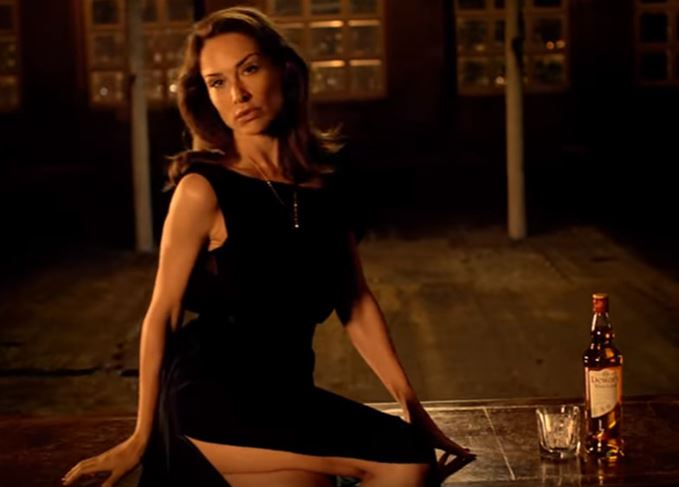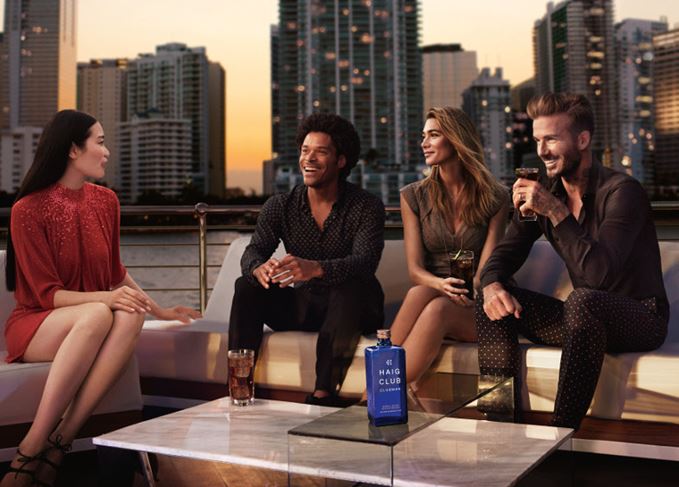The notion that Scotch is a ‘man’s drink’ is no longer accepted by the vast majority of the modern whisky world – and nor are the eyebrow-raising, sexualised adverts of years gone by. But the mix of women, whisky and advertising is still proving a dangerous cocktail, as the admen seek to broaden the drink’s appeal after decades of not always getting it right. Tom Bruce-Gardyne reports.

If Scotch whisky has a gender, you only have to look at advertising. From the start to well beyond the real-life Mad Men of 1960s New York, no-one questioned that this was a man’s drink. The hero of every campaign was male and originally Scottish – though there was some confusion in the minds of early admen. Was he a noble warrior with Claymore drawn against a backdrop of misty lochs and mountains? Or was he the comic, drunken Scot, staggering from the boozer?
Women slowly began to appear in adverts to endorse the male hero, who was invariably stuffed into a formal white tie (as seen in the advert below) if promoting Dewar’s. At some point it was realised that there was a female market worth targeting, initially as gift-givers and finally as consumers themselves. However, this clashed with what was now the primary role of women in whisky ads: to act as bait to attract men. Whisky was discovering what Champagne had known all along – sex sells.
The sexual revolution threw up endless opportunities and challenges. Sadly for Scotch whisky, growing female emancipation coincided with slow, seemingly terminal, decline in its key export market of the US. In the long-running The Good Guys are Always on the White Horse campaign, the ad agency decided the decision-maker could be female. It seems the thinking behind one particular ad from the early 1970s went roughly as follows: ‘Tough, virile Scotch should appeal to modern woman as confirmation of her new-found sense of empowerment.’ Unfortunately, the allure of vodka proved stronger – for a while.
‘Part of what makes whisky such a success globally is its overt masculine nature,’ says former adman Elliot Wilson, now strategy director at the Cabinet branding agency. ‘Its taste, its personality and provenance all direct the consumer’s mind to this outcome.’ The woman’s role as a prop in these ads is therefore no surprise.

Drink Dewar’s: Women slowly began to appear in adverts to endorse the male hero in the 1930s
‘Today, “ladies as appendages” don’t go down too well in our politically correct and metrosexual world,’ he continues, before adding: ‘As wrong as the objectification of women is, their inclusion in whisky advertising over the years has, in part, made it the drink that it is. Baggage and all, in a funny way this has helped it retain its perspective of being for the men, and therefore all the more attractive to women who actually like the association of drinking something that is clearly not for them.’
Kyle Hardie, managing director and ‘whisky expert’ at The Union ad agency in Edinburgh, adds: ‘Over the years, a number of brands have tried almost overt communication to women, while other brands, certainly in more international markets, have had women as the prop to sell to men.’
Before the internet, Hollywood actors would fly off and make booze commercials in Japan, as in the film Lost in Translation, with no fear of retribution. ‘There was some dreadful advertising created, and the star of the show wouldn’t care because he was getting a big pay cheque,’ says Hardie. ‘Nowadays, thanks to social media, it comes back to bite you.’
Today, things have changed. Hardie argues: ‘Guys are more interested in back stories. They want to say to their mates: “I drink this because…,” and to say, “because there was a very attractive woman in the ad,” is a complete no-no.’
Well, of course, but secretly they might be thinking that way. Somehow it recalls the contradiction at the heart of lads mags, whereby ‘GQ man’ is by definition someone who doesn’t need a self-help guide to being a ‘real man’.
Whatever the ethics, Hardie dismisses these as ‘wallpaper ads’. ‘You can put any brand at the bottom and it wouldn’t matter,’ he says. ‘For me, the sign of a good piece of communication is where it’s so distinctive that no other brand could do it.’ Things may have been improving until Evan Williams Bourbon hit an all-time low with the below advert from the late 1990s.

Bad for Bourbon: This 1990s ad from Evan Williams would not be tolerated today
‘Personally, I think that’s utterly horrifying,’ says Hardie. No Scotch whisky brand has ever been that tacky, though maybe Johnnie Walker’s problem was that it went too far the other way. Keep Walking was all about inspiring men to progress in life, but eventually felt slightly earnest. Hence, Joy Will Take You Further – which may suggest a condom commercial, but is actually the brand’s most lavish campaign yet, launched in 2015.
Three years earlier, Dewar’s was pursuing the ‘drinking man’: ‘A 25-29-year-old modern, urban, male whisky drinker who craves authenticity and realism,’ explains Arvind Krishnan, Dewar’s then brand managing director. The Drinking Man series starred English actress Claire Forlani as a ‘siren with the presence of a queen and the mouth of a gangster’, to quote the ad agency Opperman Weiss.
Victoria Milne, associate planner at the Leith Agency, whose clients include Famous Grouse, saw Dewar’s ‘The Drinking Man’s Scotch’ advert for the first time, and calls it ‘a baffling bad advert’ with ‘no redeeming features’. She feels the ‘Drinking Man’ title suggests men are mere ‘knuckle-dragging idiots who just like drink’, and says: ‘Because of the salacious nature of the dialogue and the voyeuristic POV it doesn't leave me thinking: “Oh, get her. I wish I was like her.”’
Suspecting the target audience was older, Milne imagines the creative process went something like this:
Creatives (Buck and Chad): ‘Ok, so how do we appeal to women and men at the same time?’
Buck: ‘Oh, I know, a sexy yet empowered woman.’
Chad: ‘You're on fire, Buck. What do 45-plus men like in a woman? Hold on, they've probably been married, like, forever, and their wives are probably quite boring and subservient. Let’s make this chick a ball-breaker.’
Buck: ‘Done.’
Powerful for the Ladies. Sexy and edgy for the men. Cue high fives and Budweiser all around.
However, leaving aside this recent Dewar’s campaign and that of Evan Williams, Elliot Wilson puts the case for the defence: ‘Laugh as we may at these ads of old, I believe that for the best part young people today don’t want whisky to change who and what it is.
‘They don’t want it to be seen to be pretending to be anything but its authentic self, as it would come across as desperate and not appealing to men or women. These adverts may have gone the way of the dinosaurs in most markets, but even so we would recommend the whisky guys not to lose the essence of what these adverts were trying to do – even if the arm candy has no place in 21st-century advertising.’





